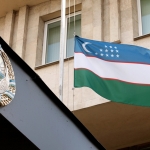31 AUGUST 2019 Y.
Between 1400 and 1401 Amir Temur’s favorite grandson, Mohammed Sultan, erected a madrassah and khanaka complex here. Mohammed’s death in 1403 prompted Tamerlane to complete the ensemble with a mausoleum.
Spanish envoy Clavijo reported how the aging emir, carried to the site in late 1404, had demanded it rebuilt with added grandeur in only ten days “under threat of a terrible forfeit to the workmen”. Although he intended burial in his hometown Shakhrisabz, Tamerlane (Amir Temur) was soon laid to rest beside his grandson and followed by descendants down to Ulug Beg, whose presence has spurred recent restoration.
Mohammed Sultan’s blue-tiled portal opens onto a courtyard once cornered with minarets and flanked by madrassah and khanaka, but today only the foundations survive. Their absence emphasizes the simple monumentality of the Gur Emir Mausoleum itself, based on an octagonal chamber decorated with geometric girikh. Above it, belting the tall, cylindrical drum, the inscription ‘God is Immortal’ thunders in white Kufic script three meters (ten feet) high. Crowning the building in fluted majesty is the sky-blue dome, gently swelling to a height of over 32 meters. Across its 64 ribs spreads a skin of colored glazed tile in a continuous lozenge pattern. Yellow and green offset turquoise-blue as light and shade play with mosaic hue.
Just as spectacular is the mausoleum interior, reached via the eastern gallery added by Ulug Beg. Hexagonal onyx tiles lend the lower walls a greenish translucence, topped by Koranic inscriptions carved in marble and painted on jasper. Geometric panels shine with radiating stars, beside niches hung with stalactites molded from papier-mache painted blue and gold. The inner dome drips an intricate gilded coating around high lattice windows.
Enclosed by a marble rail, seven marble tombstones encircle a dark-green slab 1.8 meters (6 feet) long, once the largest piece of jade in the world. Ulug Beg brought it back from Mongolia in 1425 to cover his grandfather’s grave. The split is blamed on Persian invader Nadir Shah who tried to remove it in 1740. Tamerlane lies as requested at the feet of his spiritual adviser Mir Sayid Barakah.
In clockwise order are Mohammed Sultan, Ulug Beg, Tamerlane’s sons Shahrukh and Miranshah, and two unnamed children. The horsehair pole marks the grave of a holy man, whose remains were discovered when the mausoleum was under construction. The emblem was a common sight on the hard pilgrimage to Mecca. These tombstones are actually cenotaphs matching the layout of the real graves in the vaulted crypt below, which can generally be visited for a small fee (some visitors have also been allowed into the minarets).
In the courtyard stands a great marble block carved in arabesques and known as the Kok Tash. Historians discredit the belief that this was Tamerlane’s (Amir Temur) throne, but from the 17th century, it was certainly used as a coronation stone by the Bukharan emirs. Prisoners of noble birth served as footstools. Stories claim the nearby bowl was Tamerlane’s bath (Amir Temur) for pre-prayer ablutions or even a gauge of military loss: before battle, each soldier squeezed pomegranate juice into it; once the survivors had drunk, the residue determined the number of fallen.
Buried in back yards just southeast of Gur Emir is another Timurid mausoleum, known as Ak Serai (White Palace), built around 1470. Still elegant even in ruin, the building’s cruciform chamber, arch design, glazed mosaic, and kundal gold leaf resembled the larger Ishrat Khana. Stalactites pepper the inner dome and some wall paintings also survive. Archaeologists removed a headless skeleton from the open crypt, possibly that of Abd al-Latif, son and murderer of Ulug Beg.
Following demolition that left the local neighborhood mosque standing, but without a neighborhood, a new road marks the paved path that once led north from the Gur Emir to the Rukhabad Mausoleum, built by Tamerlane at the same time to honor Sheikh Burhan al-Din Sagarji.
The grave of this mystic lent the mausoleum its popular name Rukhabad, “Abode of the Spirit”. Legend claims a casket of the Prophet Mohammed’s hair was buried with him. The classical plan—cubic chamber, octagonal drum, conical dome hairy with grass—plus lack of portal and decorous brickwork give the monument an archaistic look. Only the grand dimensions remind one of its Timurid origins.














